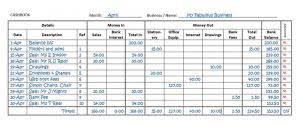
A contra asset account normally holds a credit balance as it is meant to reduce the debit balance of its corresponding asset. As the physical assets are utilized or become less valuable due to wear, tear, or obsolescence, contra asset accounts reflect this change and aid in representing the asset’s net value. In simple terms, a contra asset account is an account that reduces the value of an asset account on the balance sheet. While asset accounts usually have a debit balance (increasing when you add to them), contra asset accounts have a credit balance. This credit balance offsets the asset’s debit balance, showing the net value of that asset. Contra equity accounts adjust the equity section of the balance sheet, reflecting changes in ownership interest.

Types Of Contra Accounts
And currently, Show-Fleur anticipates that it could only sell each one for roughly $50 thousand, meaning the depreciation per vehicle is $100 thousand. Contra accounts are confusing at first, but, with a little study, understanding them becomes second nature. Let’s go over how they work and what the main types are, and then finish with an example. Double Entry Bookkeeping is here to provide you with free online information to help you learn and understand examples of contra assets bookkeeping and introductory accounting. Provision for a discount from creditors and discount on bills receivable are other widely used examples.
Contra accounts definition
- For example, if a company has an asset account for accumulated depreciation, they would also have a contra asset account to offset the balance in the accumulated depreciation account.
- Contra accounts are an indispensable part of accounting, offering a way to fine-tune financial statements without compromising the integrity of original data.
- Another example is allowance for doubtful accounts, which reduces accounts receivable’s total value, reflecting potential uncollectible amounts.
- Contra Liability Account – A contra liability account is a liability that carries a debit balance and decreases other liabilities on the balance sheet.
- For example, when depreciation expense is recorded, it increases accumulated depreciation (a contra asset) and reduces net income through the expense entry.
However, it’s important to keep in mind that you can create any contra account you want to more clearly describe your business — this is not an exhaustive or definitive list. In business bookkeeping, contra asset adjusting entries accounts play a crucial role in managing financial data and guiding strategic decisions by providing a clear picture of the true value of assets and net revenue. Contra asset accounts might seem a little intimidating at first, but they’re really just tools to make financial statements more accurate and reliable. By showing the “used up” or uncollectible portion of an asset, they provide a clearer picture of a company’s financial position.
- For example, accumulated depreciation is a contra asset that reduces the value of a company’s fixed assets, resulting in net assets.
- It represents the amount of discount that was given when the bonds were issued.
- If a company records $200,000 in revenue but then issues $10,000 in sales allowances and returns, the net revenue would be $190,000.
- For example, if a company has a negative balance in its bank account, it can create a contra account to offset the negative balance.
- The balance sheet presentation of fixed assets, thus, includes their historical cost followed by the accumulated depreciation to arrive at the net book value.
- But sometimes, dissimilar transactions are important to consider together within a ledger.
#5 – Allowances for Doubtful Debts
Understanding is accumulated depreciation a contra asset is crucial in grasping financial statements. Accumulated depreciation plays a vital role in reflecting the true value of an asset over time, impacting both balance sheets and income statements. In the complex world of financial accounting, contra asset accounts are a critical tool for maintaining accurate and transparent financial records.
Examples of contra accounts:

That car is an asset because it has value and will be used to generate income. Over time, though, the car loses value due to wear and tear—a process we call depreciation. Instead, we use a contra asset account called Accumulated Depreciation to track how much value the car has lost. Contra-asset accounting is essential for correctly displaying financial data and ensuring companies don’t inflate their assets. These accounts assist businesses in adjusting for financial risks before they become significant problems, whether related to depreciation, uncollectible debts, or product returns.

1. Purchase Discounts, Returns and Allowances Expense Contra
- Contra account accounting plays a crucial role in financial accounting by offsetting the balance of another account.
- They are used to adjust the value of related asset accounts and reflect transactions that affect a company’s financial statements.
- In the realm of financial accounting, precision and transparency are paramount.
- The following are examples of commonly-used contra asset accounts you could create to better understand your business financials.
- So, an organization looking for a robust accounting process must move to this reporting for better understanding.
- Have you ever wondered why certain asset accounts on a company’s balance sheet have a negative balance?
The purpose of this account is to increase the effective interest rate of the bonds. Contra liability accounts are used to offset the balance in a liability account. For example, if a company has a liability account for unearned revenue, they would also have a contra liability account to offset the balance in the unearned revenue account. Contra revenue accounts are used to offset the balance in a revenue account. For example, if a company has a revenue account for sales returns and allowances, they would also have a contra revenue account to offset the balance in the sales returns and allowances account. For example, a contra account is used to offset the balance in a company’s accounts receivable account.
Using contra accounts in financial analysis can provide valuable insights into a company’s management and transparency. By showing adjustments and reductions made to certain accounts, investors and analysts can better understand a company’s financial health and potential risks. Contra accounts are important in accounting practices because they help to ensure that financial statements are accurate and in compliance with GAAP (Generally Accepted Accounting Principles). They also help to provide a clear picture Catch Up Bookkeeping of a company’s financial health and performance. By using contra accounts, companies can provide a more accurate representation of their financial position in their financial statements.